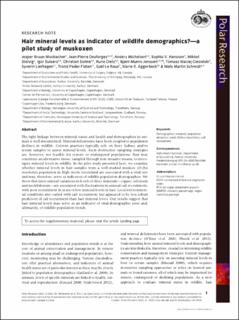| dc.contributor.author | Mosbacher, Jesper Bruun | |
| dc.contributor.author | Desforges, Jean-Pierre | |
| dc.contributor.author | Michelsen, Anders | |
| dc.contributor.author | Hansson, Sophia V. | |
| dc.contributor.author | Stelvig, Mikkel | |
| dc.contributor.author | Eulaers, Igor | |
| dc.contributor.author | Sonne, Christian | |
| dc.contributor.author | Dietz, Rune | |
| dc.contributor.author | Jenssen, Bjørn Munro | |
| dc.contributor.author | Ciesielski, Tomasz Maciej | |
| dc.contributor.author | Lierhagen, Syverin | |
| dc.contributor.author | Flaten, Trond Peder | |
| dc.contributor.author | Le Roux, Gael | |
| dc.contributor.author | Aggerbeck, Marie R. | |
| dc.contributor.author | Schmidt, Niels Martin | |
| dc.date.accessioned | 2023-01-27T12:04:04Z | |
| dc.date.available | 2023-01-27T12:04:04Z | |
| dc.date.created | 2022-11-28T12:56:57Z | |
| dc.date.issued | 2022 | |
| dc.identifier.citation | Polar Research. 2022, 41 . | en_US |
| dc.identifier.issn | 0800-0395 | |
| dc.identifier.uri | https://hdl.handle.net/11250/3046850 | |
| dc.description.abstract | The tight linkage between mineral status and health and demographics in animals is well documented. Mineral deficiencies have been coupled to population declines in wildlife. Current practices typically rely on liver, kidney and/or serum samples to assess mineral levels. Such destructive sampling strategies are, however, not feasible for remote or endangered populations. Hair may constitute an alternative tissue, sampled through non-invasive means, to investigate mineral levels in wildlife. In the pilot study presented here, we examine whether mineral levels in hair samples from a well-studied muskox (Ovibos moschatus) population in High-Arctic Greenland are associated with a vital rate and may, therefore, serve as indicators of wildlife population demographics. We show that inter-annual variations in levels of three minerals—copper, selenium and molybdenum—are associated with fluctuations in annual calf recruitment, with poor recruitment in years of low mineral levels in hair. Local environmental conditions also varied with calf recruitment but appeared to be less robust predictors of calf recruitment than hair mineral levels. Our results suggest that hair mineral levels may serve as an indicator of vital demographic rates and, ultimately, of wildlife population trends. | en_US |
| dc.language.iso | eng | en_US |
| dc.publisher | Norwegian Polar Institute | en_US |
| dc.rights | Navngivelse-Ikkekommersiell 4.0 Internasjonal | * |
| dc.rights.uri | http://creativecommons.org/licenses/by-nc/4.0/deed.no | * |
| dc.title | Hair mineral levels as indicator of wildlife demographics?—a pilot study of muskoxen | en_US |
| dc.title.alternative | Hair mineral levels as indicator of wildlife demographics?—a pilot study of muskoxen | en_US |
| dc.type | Peer reviewed | en_US |
| dc.type | Journal article | en_US |
| dc.description.version | publishedVersion | en_US |
| dc.source.pagenumber | 5 | en_US |
| dc.source.volume | 41 | en_US |
| dc.source.journal | Polar Research | en_US |
| dc.identifier.doi | 10.33265/polar.v41.8543 | |
| dc.identifier.cristin | 2082572 | |
| cristin.ispublished | true | |
| cristin.fulltext | original | |
| cristin.qualitycode | 1 | |

